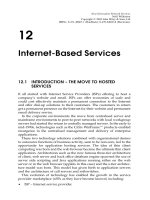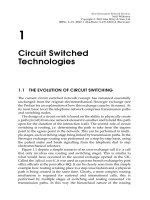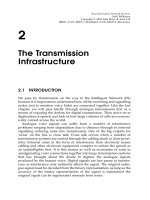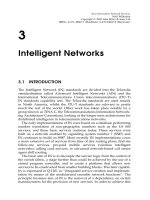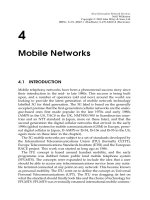Dịch vụ mạng thế hệ kế tiếp P12
Bạn đang xem bản rút gọn của tài liệu. Xem và tải ngay bản đầy đủ của tài liệu tại đây (137.35 KB, 12 trang )
12
Internet-Based Services
12.1 INTRODUCTION – THE MOVE TO HOSTED
SERVICES
It all started with Internet Service Providers (ISPs) offering to host a
company’s website and email. ISPs can offer economies of scale and
could cost effectively maintain a permanent connection to the Internet
and offer dial-up solutions to their customers. The customers in return
get a permanent presence on the Internet for their website and permanent
email delivery service.
In the corporate environments the move from centralised server and
mainframe environments to peer-to-peer networks with local workgroup
servers had started the return to centrally managed servers. In the early to
mid-1990s, technologies such as the Citrix WinFramee products enabled
resurgence in the centralised management and delivery of enterprise
applications.
These two technology solutions combined with organisational desires
to outsource functions of business activity, seen to be non-core, led to the
opportunity for application hosting services. The idea of thin client
computing was born and the web browser became the ultimate thin client
application. Architectures such as the now famous three-tier architecture
of client, web server and back office database engine spawned the use of
server side scripting and Java applications running either on the web
server or in the web browser (applets in this case) and the n-tier architec-
ture model was born. This model has given birth to application servers
and the architecture of call servers and softswitches.
This evolution of technology has enabled the growth in the service
provider marketplace (xSPs as they have become known) including:
†
ISP – Internet service provider.
Next Generation Network Services
Neill Wilkinson
Copyright q 2002 John Wiley & Sons, Ltd
ISBNs: 0-471-48667-1 (Hardback); 0-470-84603-8 (Electronic)
†
ASP – Application Service Provider.
†
WASP – Wireless Application Service Provider.
†
WISP – Wireless ISP.
†
AIP – Application Infrastructure Provider.
†
ITSP – Internet Telephony Service Provider.
†
CSP – Content Service Provider.
†
Telecom hotels – where web, email and telephony services are
provided with a building as part of the fabric like other utilities
such as water and electricity. These hosting centres are sometimes
shared, for example in the UK, London Docklands is host to Tele-
house, a building providing shared services for a number of ISPs
with international interconnections to other Internet hosting centres
and tier 1 ISPs (those ISPs with a direct connection to the main Inter-
net backbone or those ISPs who actually own some of the main Inter-
net backbone that other ISPs buy capacity on).
The forecasts for the growth and development of this market area were
extremely bullish in 2000 with all the major research organisations fore-
casting huge potential revenues from this market opportunity. Whilst the
figures may well be exaggerated the use of these kinds of services will
increase as confidence in both the technology and the ability of the SPs to
deliver on quality and security increases and of course the ability to bill
for the usage of such services. The model itself will continue to provide a
valuable architectural concept for the delivery of next-generation network
services, as it encompasses the desire for the mixture of processing power
both in the network and in intelligent devices.
All xSPs share the same characteristics, those of: offering services over a
network connection, managing the services on behalf of the customer,
providing the same service to many customers to gain economies of
scale and generally levy a recurring fee (monthly, quarterly or annually).
The concept on a rental-based service delivery is not new and facility
management companies have been providing similar services for some
time. The newness is in the delivery mechanism – over a network. Tele-
communication service providers have been providing this service for
some time and in some countries the telephone line and handset were
rented from the telecoms operator. This arguably puts telecoms operators
in a strong position as their internal processes and business systems are
set up to manage a rental approach to service delivery.
The key message from the previous paragraph is that the telecommu-
nications network operators who have decided to move their infrastruc-
tures to deliver next-generation network services are moving to a very
strong position in the marketplace. Not only will they be able to offer more
services such as application hosting (ASP), but they will be able to offer
infrastructure provision in the form of virtual private networks and dedi-
cated servers in hosting centres. This means telecommunication network
INTERNET-BASED SERVICES156
operators moving in this direction stand to have the capability to offer the
service providers services. In Chapter 14 the idea of a virtual service
provider is explored and other concepts of how the market may develop.
This very brief description outlines the change from the basic web
server, to a new application server and content delivery framework.
This framework will sit alongside and even underpin the call server
frameworks to enable the combination and collaboration of telephony
services and enterprise applications in a network-based hosted environ-
ment. Three components will form the basis of all new services, two of
which we have explored: softswitches and application servers. The third
component is infrastructure. Session Initiation Protocol (SIP), Extensible
Markup Language (XML) and Java will be the dominant technologies that
will bond this new service orientated environment together.
12.2 PRESENCE
In Chapter 11 call centre services were explored and their evolution to
presence centres was postulated. The following section explores the
concept of presence, and by the end the reader should be able to under-
stand how presence as a concept and a service could underpin many
services clambering for the throne of the elusive ‘killer application’.
One of the most compelling services to come from the Internet recently
has been Instant Messaging (IM). All the major portals and ISPs (MSN,
Yahoo, AOL/Compuserve, LineOne, etc.) offer an IM service and client
application. The early releases of IM clients were incompatible in a bid to
create tie-in to a particular portal (not unlike the browser wars that ruled
the ’net a little while back), however, more recently a number of clients
have started to appear that are compatible with the others.
The Internet Engineering Task Force (IETF) have got involved and at
the time of writing two informational RFCs have been written and three
Internet drafts under the Instant Messaging and Presence Protocol Work-
ing Group (IMPP-WG). The working group’s aim is to define protocols
and data formats for the IM and presence community, to allow robust
Internet-scale IM and presence applications to be constructed. All was not
easy with the IETF during the formation of this group and a number of
different parties all proposed different approaches to IM and presence
solutions, this finally resolved, work is still underway to complete the
standardisation effort.
The informational RFC 2778 describes presence and IM systems as
systems that allow users to subscribe to changes in each other’s state
and for users to be able to send each other instant messages. In the case
of current IM applications this state is normally represented as some form
of ‘buddy list’ and instant messages can be sent to and from both web
clients and Short Message Service (SMS) or Wireless Application Protocol
12.2 PRESENCE 157
(WAP) interfaces. IM clients also currently integrate access to email and
an online diary/calendar.
So what is the difference between IM and presence? Current IM appli-
cations only really reflect whether you are online or offline. Presence
services will reflect more dynamic behaviour linked to location-based
services and with information about the type of terminal you are using,
the type of communications you are capable of receiving.
This means the integration of technologies such as: voice over IP, IM,
mobile handsets and Personal Digital Assistants (PDAs), Public Switched
Telephone Network (PSTN) services, email and perhaps even online
games. One of the early examples of this kind of presence client is from
Hotsip, their Active Addressbooke client. It allows you to instigate multi-
player network games whilst communicating with friends either via text-
based chat session or voice/video over IP. It is designed around the SIP
protocol.
What are the key components to a presence service? Figure 12.1 shows
the key components of a presence service (this is based on RFC 2778).
The presentity software is responsible for informing the presence
INTERNET-BASED SERVICES158
Figure 12.1 Presence service components
service of the changes in the status of the user, called the ‘presentity’.In
the case of a user application as shown in the figure this is reflecting the
changes the user instigates by selecting status changes in their Graphical
User Interface (GUI). However, in an embedded application say in a
mobile device, this could reflect location updates, availability of different
communications medium (say I just walked into a room that has a wire-
less Local Area Network (LAN) or a Bluetooth LAN) or user changes.
The watcher software is responsible for receiving updates about
‘buddies’ and for instigating the subscription to the buddy’s information
with the presence service. The watcher can also do one-shot updates by
polling the presence service for an update. The watcher software is known
as either a ‘subscriber’ or a ‘fetcher’ for each of the operations outlined in
the previous sentence.
Clearly for this model to work and information to get exchanged
between presentities and presence services, a protocol and the structure
of the messages to be exchanged must be defined. These topics are still
items for discussion in the IETF-WG, but SIP is one of the strong proposals
for the protocol and a draft proposal has been made available for the
message formats for IM and presence (draft-ietf-impp-cpim-nsgfmt-
03.txt).
We started with a bold statement on presence, that it will be a key
service enabler in the future next-generation network. Maybe after the
previous description readers can form their own view as to the future
of presence?
12.3 APPLICATION FRAMEWORKS
Introduction
Let us be clear what is meant by application frameworks, as some clarity
is required. Object-oriented application frameworks are a software engi-
neering technique for presenting a skeleton of object classes that can be
used to construct a multitude of applications all based on that common
underlying framework. For example Sun Microsystems have the Swing
Java classes for constructing GUI applications that will ‘look and feel’ the
same whether the application runs on a Mac, a PC or under the X-
Windows system.
Much larger frameworks are starting to appear for the development of a
whole group of enterprise applications, examples of these are Microsoft’s
.NET (pronounced dot-NET), Sun’s Java 2 Enterprise Edition (J2EEe) and
the Java API for Integrated Networks (JAIN), an incentive to bring an
open framework for advanced telecoms service development as part of
the Sun Java Community Process.
12.3 APPLICATION FRAMEWORKS 159


